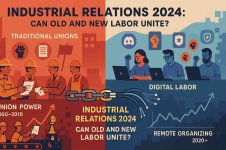"As remote work reshapes labor dynamics, unions face unprecedented challenges. Can traditional collective bargaining adapt—or will WFH weaken worker solidarity?"
Does distributed work empower employees—or fracture the collective power of labor?
(Keywords: industrial relations, remote work unions, collective bargaining trends, labor relations 2024)
Can unions reinvent themselves for the digital age—or will remote work permanently dilute labor power?
Introduction: The Clash of Old and New
The rise of remote work has quietly ignited a crisis in industrial relations:- Union membership has dropped to 10.1% (2023, BLS) as hybrid work grows
- 82% of remote workers say they’ve never met union reps (Gallup)
- Companies like Apple and Google now ban remote employees from union chats (NLRB complaints)
Does distributed work empower employees—or fracture the collective power of labor?
(Keywords: industrial relations, remote work unions, collective bargaining trends, labor relations 2024)
Section 1: How Remote Work Disrupts Traditional Union Models
1. The Geography Problem
- Unions rely on physical worksites for organizing (e.g., factory floors)
- Case Study: Amazon’s JFK8 warehouse unionized—but its remote tech staff remain non-union
2. Surveillance vs. Solidarity
- 37% of remote workers report being monitored by bossware (Gartner)
- Unions struggle to counter digital union-busting (e.g., Slack message filtering)
3. The "Lone Wolf" Effect
- Remote employees negotiate individually (salary, flexibility)
- Risk: Erodes "collective struggle" mentality (UC Berkeley Labor Center)
Section 2: Unions Fighting Back—Digital Tactics
1. Virtual Organizing Drives
- UAW’s Discord-powered campaigns for Tesla remote engineers
- NFT membership cards (UK’s CWU trial)
2. Leveraging Data Privacy Laws
- GDPR/CCPA used to limit employee monitoring in the EU/California
3. "Micro-Unions" for Digital Nomads
- Freelancers Union’s location-agnostic benefits pools
Section 3: The Path Forward
Hybrid Solutions Emerging
- Microsoft’s Labor Neutrality Agreement (covers remote workers)
- Starbucks’ "Virtual Picket Lines" (geo-targeted protests)
Can unions reinvent themselves for the digital age—or will remote work permanently dilute labor power?

